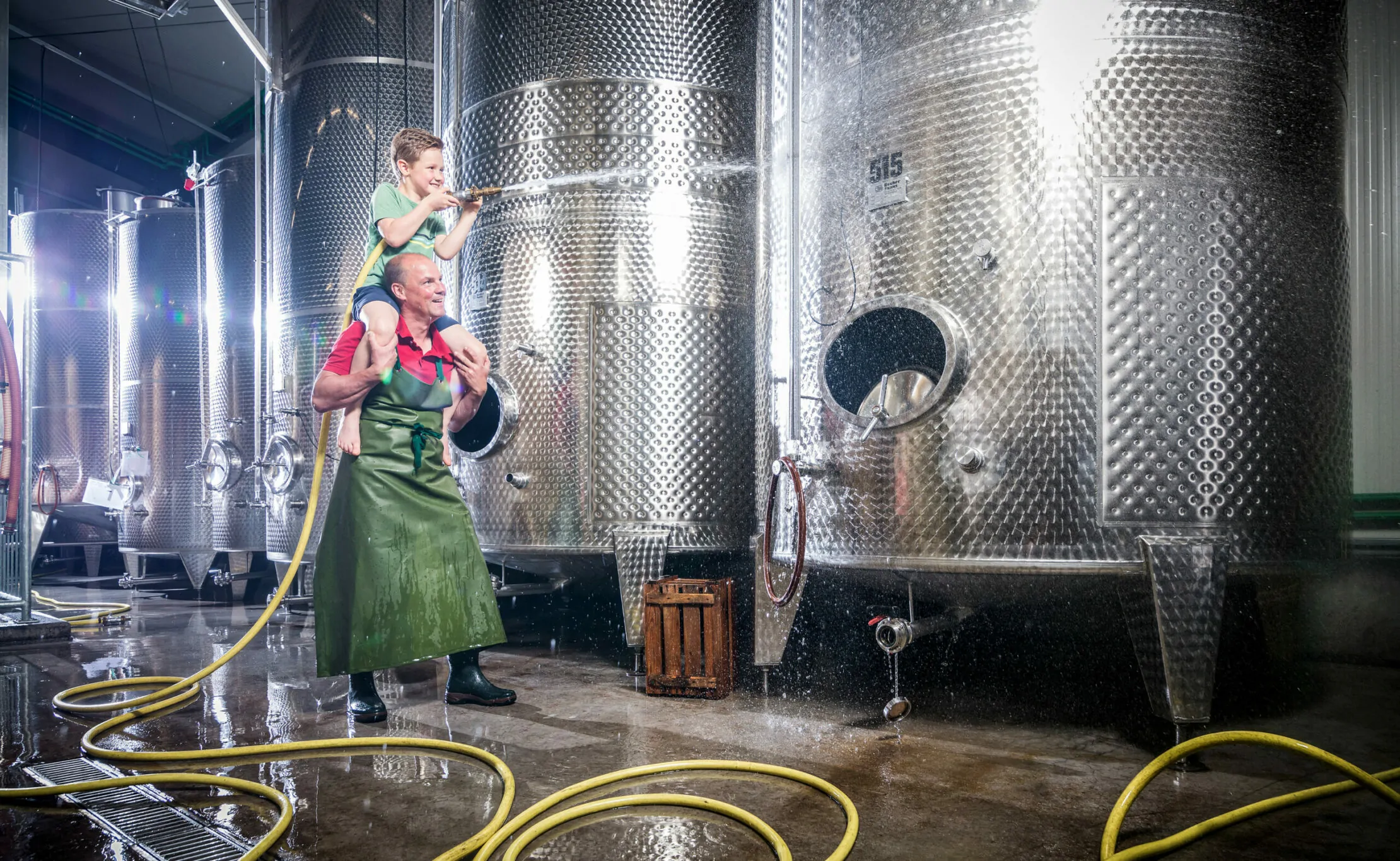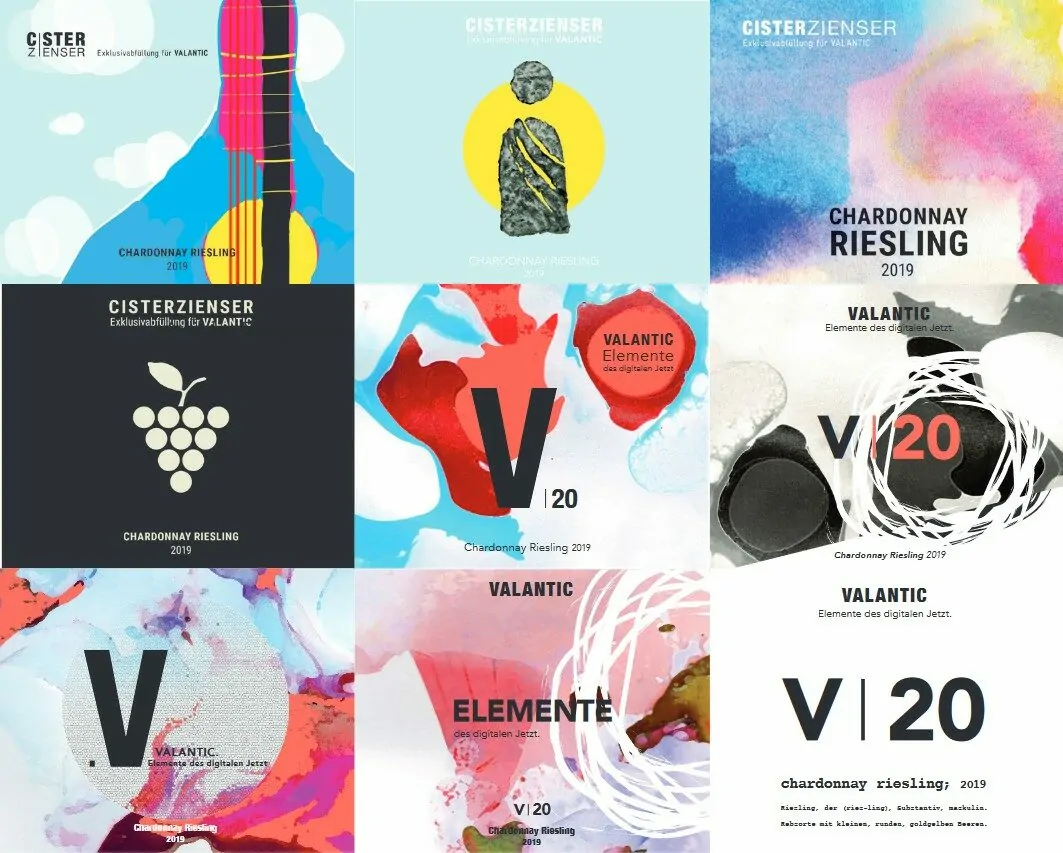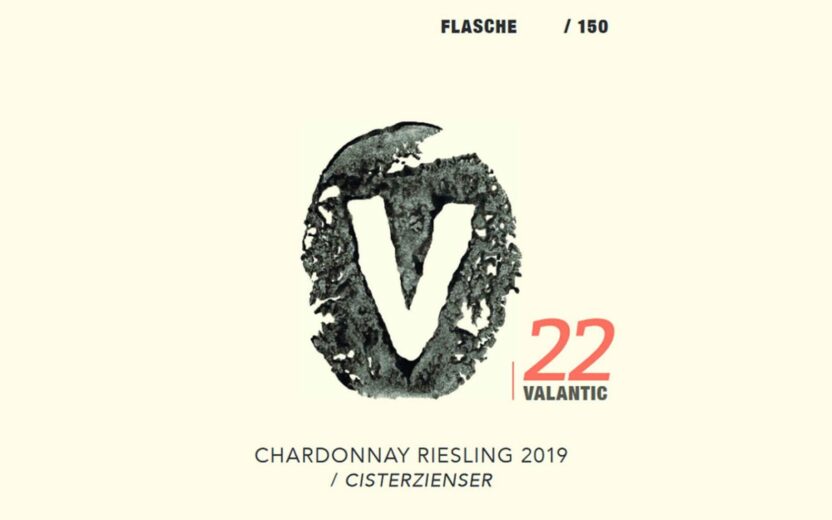Chardonnay Riesling 2019 / Cisterzienser
Cuvée „v22“
How does something new come about? Through connections, obviously! Or bonds, at least from a chemical perspective. But also interpersonally. Even economically – more on that later. First of all, here’s the oenological take: Riesling with Chardonnay, that’s…no, not like fire and water, but still a little like north and south, Johann Sebastian Bach and Miriam Makeba, Annegret and Rodrigo. It can all fit together. However, this requires several virtues at once: Tolerance and respect, tenacity, the art of living, expertise…and a whole lot of love. So it is no wonder that an all-rounder was born: The cuvée “v” has the melt of Chardonnay, the liveliness of Riesling, it looks well-balanced, and it’s never boring for a second. On the one hand, there is elegant acid thanks to the minerals, which drive all our receptors to peak performance. On the other hand, a gentle smile, in a good mood like a buttercream cake that heats up our pleasure sensors. The two together magically induce you to take the next sip. And another sip. All of a sudden, the bottle is empty: A wine for refined pietists and converted erotomaniacs. From here for everywhere.
Then there’s also the culinary aspect: It pairs well with pasta, loves Saltimbocca, but also scaloppine, supreme de volaille, even smoked fish, and baked goat cheese with tomatoes; it doesn’t even hesitate with salads. It goes with almost everything: It even goes with you, by yourself, in mid-March at 5:00 PM on the terrace or at the end of July from 11:30 PM to 1:45 AM. Or at the beginning of February, sometime, on the sofa. Then it whispers to you: “Hey … psst … what kind of face are you making over there? Watch out, I’m the start of something new. Look, it’s getting brighter!” How does something new come about? Let’s ask the mystics. Myein, that is to say close (your eyes), go together. Opaque processes? Black box? For laymen only. Philosophy has its terms: Unio mystica, the marriage of the divine and the human; coincidentia oppositorum, the clash of opposites. Wine people have different terms. The result? Enlightenment, of course! The path to higher knowledge is open to everyone. Let’s follow it. It’s a therapeutic process. What did “therapeutics” mean in Greek again? To help, heal. Precisely. Something new emerged here: A cuvée. In the past, it would have been called a blend.
Even Uli’s papa called it that. And he was against it. Until he tried the wine – and then served it on his 70th birthday. You learn something. All sorts of things come together. As with wine, you might even imagine a company: Two companies, many companies, established independently of one other, which eventually become one…and one day, they give their favorite customer a gift that is just like them. Two make one, and it’s greater than the sum of its parts. Higher harmony. Or just drinking pleasure. Don’t brood over it for too long. Bring up the bottle. Mmmmmm!
Dittelsheim-Heßloch is not Bernkastel-Kues, nor is it Oestrich-Winkel, nor even Schweigen-Rechtenbach on the traditionalists’ map. But grapes grow here too – and what good grapes! These are not sloping vineyards. Those are in Rheinhessen, at most over there on the Roter Hang, a few kilometers away, once the most expensive wine-growing location in Germany. No, these are grape gardens, soft and wonderfully curved, the soils are rich, multi-layered, an imperative for all wine-makers: Hey, make something of me! Part 1 of the cuvée “v”, a Chardonnay, grew in the “Heßloch moonlight.” There’s nothing more romantic, is there? Some say that they hear Glenn Miller’s “Moonlight Serenade” when they’re drinking it…others prefer to look at the ground and realize that here, clay and lime marl dominate and there is an optimal water supply. A stone’s throw away, part 2, Bechtheim district: The Riesling. A considerable proportion of iron ore provides a very special mineral content. An acid that is not too sharp, but slightly fruity.
People have known about the advantages of these locations for a long time. For a very long time: From the Middle Ages to the Reformation, the knowledgeable Cistercians cultivated much-acclaimed wines here. Immediately after that, the Michel family took over – and they are still there today, thank God! Without heavenly help, eight generations probably wouldn’t have persisted. So it’s historical ground. And there’s a lot to learn, we promise! The main discovery: The people and their wines. An ancient and yet quite young vineyard. By the time he was 15, Ulrich Michel realized that becoming something other than a vintner wouldn’t suit him. For “it’s the best profession in the world!” His parents, who had only been bottling since 1986, from the start with dry wines, had the foresight to let the boy do what he wanted to. University studies in Geisenheim – but why? But OK. Training in South Africa? If he really wants to…of course, all of this didn’t happen without some conflict, but you learn from one another. You grow together. When the successes trickle in, there is reason to celebrate. But nobody stands out here. Uli Michel is not a wine technocrat.
It’s not his intention to torture people with doggedly ambitious vintages. Accessibility is the opposite of arrogance and good drinking is a state of happiness. He was inspired by New Zealand (Sauvignon Blanc!) and South Africa (Stellenbosch: Chardonnay!). He came back home, what luck. He infects people with his effervescence, his optimism. He knows exactly what he has in his wife and four children. They are the center. Here, in Dittelsheim-Heßloch.
Sometimes when you meet a couple, you think: Oh God, how do they stand each other? And then you learn that these two have been together for 25 years and seem quite happy. She is so cheerful, as pleasure-seeking as sanguine, an actress at the city theater, popular with the produce merchant and her superiors, and beloved by all the cats…and he? For God’s sake: He doesn’t do anything. He’s something between an eco-gardener and a hobby artist. And he also serves as a volunteer in the day care center! What does she see in him? Well, at home he creates the good mood, he’s balanced until provoked, he offers the perfect counterpart to her hectic nature. Is this a dream marriage? A dream marriage. But what did we actually want to say? Oh yes, we were telling you about the wine. The blending, that is, the marriage.
Two different characters in fluid form. The vintner as matchmaker. And a marriage counselor: For especially in the first few months, it is important to balance things out, to have an ear for both sides. It’s actually about who has the upper hand.
This changes from year to year, but even in the vineyard, the vintner is working to ensure that they are well-suited to each other. The Chardonnay: Beautifully ripe, but not expansive. The Riesling: Some of it is harvested early in order to maintain the crispness. And so the two complement each other, so they have a chance in the long run.

This is what you learn in Geisenheim. No amateur should think they can keep up unless they have studied microchemistry…we can only report what’s going on from the outside: A part of the Chardonnay was aged in the tonneau (medium-sized wooden barrel), which gives it that delicate barrique touch. The rest, Chardonnay and Riesling separated and temperature-controlled, in stainless steel. A difficult fate awaits the vintner: He has to taste the wine time after time! The wines remain on the fine yeast for as long as possible until they are finally allowed to mix two to three weeks before bottling. One hour beforehand, experiments are performed: What is the best mixture? In such a case, ten liters in 5000 can be decisive. You have to stay with them even in the bottle. When are they best to drink? Starting in May, June, the initial signs are good. In September, they will find each other. But they are happiest when October is over. Do you know now why this wine tastes so good? You don’t? Then take another sip. And one more. That’s how you make discoveries. You can already taste the results.
It’s time to answer that question. We have promised to reveal what creating something new from particular connections or bonds means economically. We all know that company mergers often fail. That teams that work together do not manage to harmonize. In the world of wines, these would then be non-harmonious cuvées.
At the same time: Real innovation can often only come about when different people, teams, and companies combine their expertise, develop it together, and create a unique service offering. Especially in the digital world. Everything is moving faster, the requirements are increasing, and innovation can only be achieved with a large number of highly specialized teams, who work cooperatively and in harmony. That’s what motivated Holger von Daniels in the time before valantic was established: To set up a digitalization service provider that understands complex projects holistically and can deliver high-quality results. One that constantly develops and questions itself, but at the same time values long-term relationships with customers.
How do you do that? Well, you have to master the art of integration. More precisely, you have to connect many smart people and teams, cultures, entrepreneurs, and companies to form a strong group. And let them bring in their best skills – for the benefit of the whole.
In practice, this means that today, valantic can offer true end-to-end digitalization along the entire value chain. That’s diversity. Did you notice anything? The analogies with the processes to create the cuvée “v” are numerous. As far as diversity is concerned, we could almost speak of a “mixed batch.”
And there’s something else that creates a bond: Quality. “Our aim is to break through established patterns of thought. To this end, we combine technological experience with specific industry expertise. That’s how we want to become Number 1 in the market areas we serve. That’s how we will achieve perfection in the digital transformation.”
This is a clear claim that can easily be reformulated to include wine. And one more thing, the claim: “valantic. Elements of the digital now.” The pleasure of the cuvée “v” is just the same: Celebrate the moment, gain and maintain an awareness of the present. Or as the wine connoisseur Goethe put it: “I will say to the moment: Stay a while, you’re so beautiful!”
The journey was the reward. But the reward is also very nice.

Ulrich
Without him, we would have to drink Bluna. (Eww!) He’s the vintner, he knows the grapes. Picks them. Presses them. And makes the wine. He also supplies the stories. Actually, he does everything. Nice for us!
Johannes
The co-author. Sometimes a cribber. Has been writing about wine for twenty years, and it has never done him any harm. Or so he claims. He also comes from Frankfurt. That means you have to be an idyllist.
Anjulie
“A bottle without a label, a wine project without a booklet. Working like that would be akin to having to buy the cat in the bag.” She loves design and wine – an ideal cuvée.
Matthias & Christoph
Sacrificed themselves to select the wine. Poor guys…

Booklet of the valantic wine project
The content on this page can also be taken from the booklet. Download now!
We look forward to your feedback at wein@muc.valantic.com or directly here!